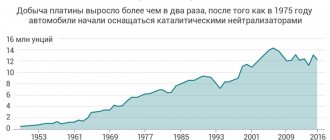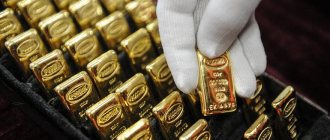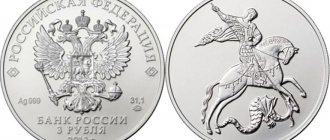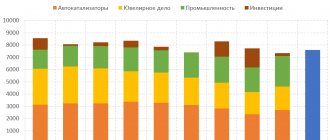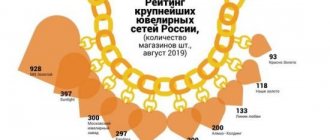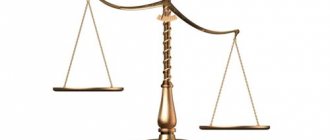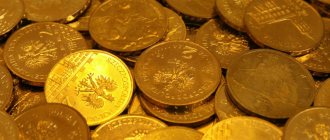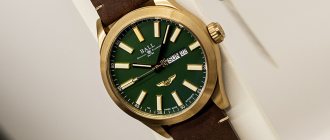Investing in gold has always been a profitable investment. This material does not depreciate, does not deteriorate, and can be stored for a long time. It is not surprising that many are trying to invest in this type of investment.
Before purchasing a gold bar, you need to familiarize yourself with the rules established for banking circulation of precious metals, clarify how much a standard gold bar weighs, and other norms adopted in this sector. There are several types of gold bars. In addition, there are differences in the method of making bank bullion.
So, the price of 1 kilogram of gold is approximately 1,850,000 Russian rubles
In dollar equivalent, this will be $36,865. On the world gold market, quotes are formed largely based on the results of daily speculative transactions. At the same time, experts try to link the cost of gold with the amount of precious metal actually mined and produced. But there is no direct relationship observed here. There is only an increasing fall and winter demand associated with the traditional Asian wedding season.
Clearer patterns are observed in the foreign exchange market. The chaotic nature of this segment of the financial system forces many investors to turn to gold, which is more stable in the long term. And many experts explain today’s rise in prices for the yellow metal by the fall in the exchange rate of the US dollar. People stop trusting unstable currencies and turn their attention to gold.
Why is pricing so difficult?
It is important to understand that gold should be considered solely as a long-term investment. Its real value is growing, albeit slowly, but surely. So, over the past half century it has doubled. That is, by selling a gram of gold you can now buy twice as much of the precious metal as in the early 70s. Although, if you are interested in long-term investing, then this is a good and very real prospect. It is suitable even for private investors. After all, you can make an investment in almost any commercial structure. The same goes for selling. Let's look at this in more detail.
How the price of gold is formed
During the monometallic financial system, the price of gold, independent of the monetary equivalent, was irrational. Its real price became clear only after the abolition of the gold standard. In this case, two types of prices can be distinguished: officially accepted and market quotes. The official exchange rate was artificially distorted by the US Treasury for about four decades. Depending on the state of the dollar, at different times the price of gold could be $35, $38 or $42. These figures are very far from market quotes, which could even reach $850 per ounce in the early 80s of the last century. Therefore, the formation of the price of the yellow metal has always depended on complex international interaction.
The graph shows changes in the value of the precious metal from the beginning to the end of the 20th century.
The US-led International Monetary Fund forced countries in the post-war period to settle in gold only at the official rate in order to support and strengthen the dollar. This gave rise to some countries, such as Italy and France, to secretly speculate in purchased gold, profiting from the difference in price. This allowance was called “lazh”. It was measured as a percentage. If a gold bar in post-war France was purchased for $90, then it could be sold for $55 more. At the same time, the error rate was 157%.
Buying and selling
Trading in this product is primarily the prerogative of banks. You can not only buy gold there, but also leave it for storage. Such a financial investment has a high level of profitability, but only in the long term, since the purchase price will be higher than the sale, as with other foreign exchange transactions.
What determines the price of a bank bullion?
In addition to the current gold rate, the price of the product is tied to its weight. The buyer pays the most money if he purchases metal weighing 1 gram. The higher the weight of the ingot, the cheaper the gold is per gram.
Products in poor condition, on the contrary, are accepted at banks, charging an additional commission of about 3% of the value of the metal.
How much does a gold bar cost in Russia 1 gram and 1 kg
As of today. 1 gram of gold costs:
| Price 999 standard according to the Central Bank | Market value of the sample today | Scrap price | Price in jewelry |
For an ingot weighing 1 kilogram you will have to pay (in million rubles):
Where is the best place to buy bullion?
It is always better to purchase such things from financial institutions. In this case, the possibility of forgery is eliminated and the availability of the entire package of accompanying documents is guaranteed.
Where and how to store the bullion
The storage of gold, including in coins, should also be entrusted to the bank. It’s not safe to keep such valuables at home, and there’s no point in keeping them. The financial institution opens a metal safekeeping account for the client - an analogue of a safe deposit box. You can put all your precious savings there, add new ones or withdraw the necessary part.
The cost of such a service will not depend on the number of items, their weight and even the metal from which they are made - all your savings in precious metals can be kept in one place.
To see how Russia's gold reserves are stored, watch the video:
Formation of a gold pool
In the 60s of the last century there was an organization called “Golden Pool”. It was she who regulated the price of gold at the global level. Its participants and organizers were the USA and 7 European countries. The "Gold Pool" aimed to achieve a balance between the market and official levels of the value of gold when trading on the British market. Every month the English bank bought and sold the precious metal at its own risk. The balance was then divided among the participating states, depending on their contributions to the common cause from their reserves. Maintaining the market price level was achieved by selling their own gold reserves by countries that were members of the Pool.
The main goal of the “Gold Pool” was to support the gold backing of the dollar.
In the fall of 1967, the British pound fell and the resulting “gold rush” required as much as 3 tons of the precious metal to be settled. After this, the pool was dissolved in 1968.
Artificial cost control has lost out to real pricing factors based on supply and demand. This was a failure of American policy, which, as always, consisted of artificially maintaining the dollar at the expense of the funds and efforts of partners.
Tax
Buying gold bullion is a good investment if you want to protect your money. But for this you need to have large funds and invest them for a long time. A serious obstacle on this path is the 18 percent VAT on the cost of gold.
There are also various kinds of “metal accounts” in banks. They will save you from VAT and eliminate the hassle of storing bullion. But they won’t be able to give you the unique feeling of owning a precious metal!
Sberbank of Russia occupies a leading position in the precious metals market, having an impressive network of branches throughout Russia. In addition to operations with compulsory medical insurance and precious coins, Sberbank sells bars of gold, silver, platinum and palladium. What precious metal bars can be purchased at Sberbank, how bars are classified according to their condition and the presence of certificates, and how this is reflected when selling precious metals to the bank - these issues are covered in this article.
So, let's start with the fact that at Sberbank you can purchase measured and standard ingots produced at Russian refineries in accordance with current Russian GOSTs and international standards. There is no point in studying the standards before purchasing a gold bar from Sberbank or any other Russian bank, because... Acceptance of ingots from the manufacturer involves checking each ingot. If the ingot does not meet the standards or has unacceptable defects, then the ingot is sent to the manufacturer for remelting.
The Double Gold Market Phenomenon
Before 1973, there were two gold markets. In the official segment, Central Banks traded precious metals at reduced prices, thereby supporting the American dollar. In the private segment, the price was formed based on real supply and demand. After America abolished the gold backing of the dollar, the official market simply collapsed. In the fall of 1973, the central banks of leading countries stopped operations with gold at reduced prices. The artificial price parities of the official gold market were completely abolished by 1978.
The graph shows the upward trend in the value of gold in the first decade of the 21st century.
The market price of gold bullion can be influenced by economic conditions, politics and speculation. The rise in value is driven by increased household, industrial and investment demand. If the economy is in a fever, inflation and payment imbalances are growing, along with fluctuations in exchange rates and lending rates, then the cost of gold always increases.
At the end of the 70s of the last century, the West was literally gripped by a “gold rush”. The price of 1 kilogram of gold went through the roof. Then, until the end of the century, negative dynamics were observed, interspersed with minor changes.
The main reason for what is happening is the strengthening of the position of the US dollar and US government bonds against the backdrop of curbing inflation. As a result, interest in the yellow metal has diminished in many countries.
To compensate for budget deficits and reduce public debts, many countries at the end of the last century began to sell off their gold reserves.
When considering global market processes, it is also worth taking into account the multifaceted essence of gold itself, which can be a promising asset, a foreign exchange reserve, and a necessary raw material.
Measured (cast) and standard (stamped)
Compared to standard ones, measured gold bars look more beautiful. Photos of them can be seen in this article. Measured ingots of the purest standard are produced in different weights: from 1 gram to 1 kilogram.
There may be a concavity on the surface of the ingot as a result of metal shrinkage with a depth of no more than 5 mm.
A standard gold/silver bar on its large base should contain the following markings:
- ingot number;
- grade of precious metal;
- mass fraction of precious metal (sample);
- ingot mass;
- symbols of the country of origin;
- refinery trademark;
- year of production of the ingot.
Standard platinum and palladium bars
Standard platinum and palladium ingots must meet the following requirements in accordance with the specified GOSTs:
- The maximum weight of standard platinum bars can be 5500 grams. The maximum mass of a standard palladium ingot is 3500 grams.
LBMA (London Bullion Market Association) and is sold in all countries.
The cast kilogram gold bar is the largest bar in the Heraeus product range. Popular among investors both in Europe and abroad.
Each Heraeus 1000g gold bar:
- •1000 grams of 24-karat 999 gold;
- •ingot dimensions - 117 mm x 51.5 mm x 9 mm;
- •blister packaging that protects against damage;
- •quality certificate from the Heraeus refinery;
- •a unique serial number, which is indicated on the ingot itself and in the certificate.
Why do investors choose Heraeus 1kg bar?
As soon as savings appear, the question arises of how to preserve the accumulated amount, and also, preferably, increase it.
By agreement between the customer and the manufacturer, the weight of the ingot may differ.
- Gold bars must have the shape of a regular truncated pyramid with certain dimensions of the base sides and height (thickness). The refinery has the right to produce ingots of other shapes and sizes as agreed with the customer.
- The standards establish grades of gold and silver, and also determine the composition of impurities and their maximum content in the alloy.
- The surface of the ingot must be free of sagging, burrs, grease stains and deposits, and the presence of slag and other foreign inclusions is not allowed.
- On the surface of the ingot, the presence of stripped areas with a depth of no more than 1 mm for standard gold bars and no more than 3 mm for standard silver bars is allowed.
Important
By agreement between the customer and the manufacturer, ingots of other weights can be produced.
- Ingots must be rectangular in shape with certain side dimensions: length 100 + 3 mm, width 65 + 2 mm, the height of the ingot is not regulated. The manufacturing refinery can produce platinum and palladium ingots of other shapes and sizes as agreed with the customer.
- GOSTs establish acceptable grades of platinum and palladium and the composition of impurities, as well as the maximum content of each impurity component in the alloy.
- The surface of a standard palladium and platinum ingot must be machined. The presence of any foreign inclusions is not allowed.
In this case, let's start with information about what measured and standard bars of gold and precious metals are available.
Bullions produced in the European Union comply with international standards established by the London Bullion Market Association (LBMA).
All bars must meet state standards, which you will learn about in this article.
The price of gold depending on its functional purpose
In the modern world, gold can be present in the following functional and qualitative incarnations:
- As an industrial raw material resource.
- Like a piece of jewelry.
- As a means of accumulation in the form of bullion.
- As a collectible in the form of coins.
- As a trading exchange instrument.
Price formation in each of the listed cases is quite specific. The cost will depend on the relationship between supply and demand, production and processing costs, speculative stock market trends, etc.
Ingot Certificate
The authenticity of each timber must be confirmed by a quality certificate - a kind of passport issued by the manufacturer. The document contains the following information:
- official name of the plant;
- sales imprint;
- name of the item;
- metal sample.
On the surface of a valuable item there must be identical images of a brand, stamp and trademark, which indicate that this product is made from pure high-grade metal and its value corresponds to the specified quality. The imprints on the bar itself are also a certificate of the design.
Another mandatory document is the declaration of conformity, which is issued based on the requirements of Government Decree No. 982 of December 1, 2009 for certain types of jewelry.
Current gold price
The price of gold is measured in United States dollars. Today it is $1,188.7 per troy ounce (31.1 grams) on the stock exchange. In terms of Russian rubles, this will be 2,469.8 rubles per 1 gram.
Depending on the intended use of the yellow metal, the quote may vary.
How much does 1 kilogram of gold cost if we consider it as an instrument of investment and accumulation?
To use yellow metal for these purposes, it is best to purchase bullion or open a metal account at a bank. What is good and bad about each of these options?
Interesting Facts
The significant value of the described product was noticed by representatives of ancient civilizations. For example, Egyptian scripts contained information according to which, in the process of trade settlements, 1 g of the yellow metal was compared with 2.5 g of silver. This factor is quite understandable, because during the growth of cities, an economy was created and strengthened, which subsequently contributed to the formation of separate states.
Gold as a universal method of payment became established during the development of foreign economic and commodity-money relations. As a standard, it was measured in grams, for which regular weighing procedures were carried out. In order to facilitate the calculation procedure, back in the 6th century BC. e. The first blanks made from a mixture of silver and gold appeared.
Convenient investment
The cost of 1 gram of gold - investment grade gold with a three-nine hallmark - is set every day by the Russian Central Bank. It is published in official sources. But this is not the price that is used when purchasing precious metals. Based on it, calculations in the financial sector only take place.
The price of precious metal in bullion will always be higher than the exchange price due to the costs of production, sale and payment of VAT of 20%. Thus, taking these factors into account, the cost of the bar will depend on its weight and the content of chemically pure gold in it. So, if the sample of a precious metal is “three nines,” this means that 1 kilogram of the alloy will contain 999 grams of yellow metal.
If you want to save money, open a metal bank account. In this case, there is no need to pay VAT, spend money on renting a cell, etc. Again, such a deposit is easy to cash out at any time.
Main characteristics
Gold is not only a beautiful metal with a lot of positive characteristics, but also an alloy that is not subject to oxidation and does not darken over time. It can act as a conductor and is widely used for medical purposes. Due to its properties, gold products are incredibly durable, and due to its antiseptic properties, it is used in some medicines and cosmetics.
This precious metal has an incredibly high density, so even the small size of gold bars provides a decent weight to the product. For example, a small ball with a diameter of only 5 cm weighs more than a kilogram. Used in many areas of life, this metal can also be called an excellent means of investing money. This hard currency can be exchanged for the money of any country in the world.
How much does 1 kilogram of gold cost?
So, an impersonal kilogram of gold in a metal bank account will be valued at approximately 2,750,260 rubles. The cost of the measured ingot must be clarified with the bank for each specific date.
The exchange quote in 2016 was at $1,200 per 1 troy ounce. But this indicator is unstable and changes daily depending on many reasons - world politics and economics, changes in exchange rates, financial risks, etc. Daily exchange rate fluctuations can be up to 10%. To make the most of your gold investment, it is always a good idea to stay updated with the market situation.
You may also be interested in::
- News and analytics of the gold and coins market
- Golden educational program for investors
- Catalog of gold coins for investment
- Critical mistakes when investing in gold
- How to make your investment in gold profitable?
What to do if you are determined to buy precious metal in a bank?
So, you have decided that at the moment the most profitable investment of money is buying a gold bar. What to do now? Where to begin? First you need to find out which Sberbank branch provides this service. You should also find out whether the department has special rooms for storing gold bars, and whether specially trained specialists work in this department. Next, you should think about the ingot itself. What amount can you spend, what weight are you interested in. Have you decided everything? You can go to the bank, not forgetting to take your passport with you, without which the transaction will be impossible.
